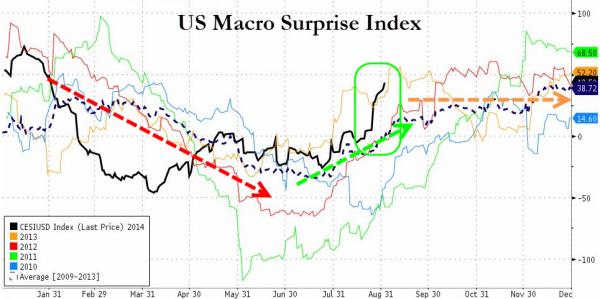For the past five years there has been a very clear and significant cycle to US macro data – a slight rise to start the year, notable weakness into the middle of the year, a rapid recovery into the fall, then generally flat to year-end. A year ago, we explained this cycle appears to be created by government agencies need to spend, spend, spend their budgets out ahead of fiscal year-end (Sept).

Â
This year has been no different, aside from the knee-jerk higher in macro data – somewhat shocking in its magnitude to ‘every’ economist with 3, 4, and 5-sigma beats in many data – came a little earlier but to the same level of past year’s exuberance (as perhaps Ex-Im concerns, Fed concerns, and election concerns sparked earlier-than-usual spend-down by agencies).
The last few weeks have seen US Macro surge faster compared to expectations that at any time since the initial takeoff from the 2009 lows… and note, every time we surge at this pace, US Macro tops out!

Â
As in past years, this spike in activity is extrapolated by the smartest people in the room, leaving the reality to miss expectations for the rest of the year. A glance at the chart above might suggest, we just jumped the shark once more in US macro data for 2014…
*Â *Â *
A year ago, we explained this cycle appears to be created by government agencies need to spend, spend, spend their budgets out ahead of fiscal year-end
This begs the question: is the only reason why the economy tends to pick up momentum dramatically as the summer ends just a function of a surge in government spending permeating the broader economy as agencies scramble to spend all the money they have before the end of the September 30 Fiscal Year End (just so they get allocated the same or greater budget in the coming fiscal year), which subsequently plunges or is outright halted as the case may be right now?
If so, it would explain so much, and certainly why year after year, the US economy seems to pick up in the mid-to-late Q3 period, only to dramatically fade away in the coming months, as government spending goes from a waterfall to a trickle.
It would also put the government’s role in generating transitory periodic spikes in economic output under a microscope, especially since it is so clearly staggered to recur every September as one after another government agency spends like a drunken sailor. And if that is the case, how long until the BLS or some other agency (upon reopening of course) is taken to task to normalize not only for hedonic indicators and climate-related seasonal factors, but also for what is now clearly an annual aberration of economic output trends?

